skip to main |
skip to sidebar
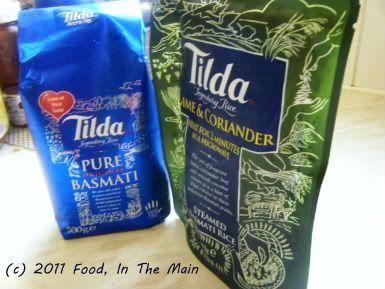 Recently I was sent a few samples of Tilda basmati rice to try. I've always gone for Kohinoor basmati, I guess because that's what I've been using right from my India days. I've NEVER used instant rice or bothered with the ready-cooked stuff available in supermarkets - the "just reheat" type.
So I was kind of meh when I saw that there were two packs of pre-steamed flavoured basmati rice along with the pack of plain uncooked basmati. One was a Sweet Chilli & Lime rice, and the other was Lime & Coriander. They only needed two minutes in the microwave to be ready for consumption.
Recently I was sent a few samples of Tilda basmati rice to try. I've always gone for Kohinoor basmati, I guess because that's what I've been using right from my India days. I've NEVER used instant rice or bothered with the ready-cooked stuff available in supermarkets - the "just reheat" type.
So I was kind of meh when I saw that there were two packs of pre-steamed flavoured basmati rice along with the pack of plain uncooked basmati. One was a Sweet Chilli & Lime rice, and the other was Lime & Coriander. They only needed two minutes in the microwave to be ready for consumption.
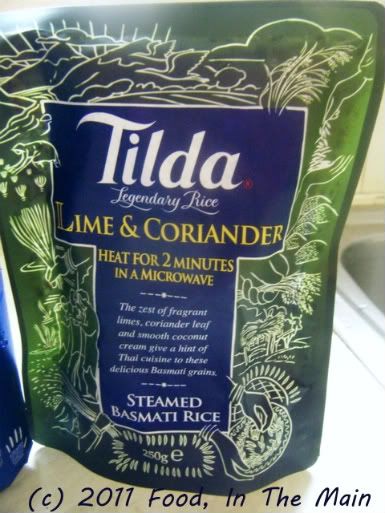 I chose the Sweet Chilli & Lime to try, on the principle that anything with "chilli" in it automatically meant that Pete would not really want to try it! The ricetasted nice, and the grains were cooked through properly and each grain was separate - but somehow they seemed TOO separate. At any rate, I've never been able to get that sort of "each grain separate" effect at home. Oh, and there wasn't nothing "chilli" about it!
Pete tried the Lime & Coriander, and while he liked the taste and texture, he said it still came second-best to freshly cooked rice. Fair enough, I guess... so my verdict is that while the instant rice varieties brought out by Tilda are a good last resort if you're short of time, I would still always go for freshly-cooked basmati as far as possible.
I chose the Sweet Chilli & Lime to try, on the principle that anything with "chilli" in it automatically meant that Pete would not really want to try it! The ricetasted nice, and the grains were cooked through properly and each grain was separate - but somehow they seemed TOO separate. At any rate, I've never been able to get that sort of "each grain separate" effect at home. Oh, and there wasn't nothing "chilli" about it!
Pete tried the Lime & Coriander, and while he liked the taste and texture, he said it still came second-best to freshly cooked rice. Fair enough, I guess... so my verdict is that while the instant rice varieties brought out by Tilda are a good last resort if you're short of time, I would still always go for freshly-cooked basmati as far as possible.
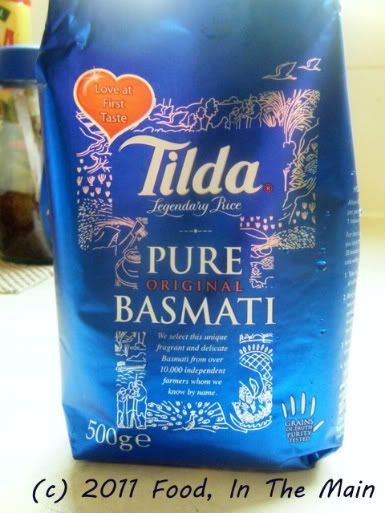 And talking about freshly cooked basmati, the Tilda basmati "dry" (uncooked) rice was fabulous! I soaked the rice for an hour or so before cooking it, and the grains were quite amazingly long, almost as long as giant wild rice (easily 1cm or more). The aroma was lovely, too, and if it turns out that Tilda is cheaper than Kohinoor, I might just switch loyalties - or perhaps divide my loyalties between them... seems like less of a betrayal, wouldn't you say?
And talking about freshly cooked basmati, the Tilda basmati "dry" (uncooked) rice was fabulous! I soaked the rice for an hour or so before cooking it, and the grains were quite amazingly long, almost as long as giant wild rice (easily 1cm or more). The aroma was lovely, too, and if it turns out that Tilda is cheaper than Kohinoor, I might just switch loyalties - or perhaps divide my loyalties between them... seems like less of a betrayal, wouldn't you say?
I call this a Thai-style curry because an authentic Thai curry was not what I had originally set out to make – and anything that’s not authentic can only be termed “-style” in the interests of accuracy (and also to forestall any comments from my self-adopted pet troll along the lines of “this isn’t how you make an authentic Thai curry, you pathetic poseur, call yourself a real cook?” and so on.)
Pete had asked if I could make him a South Indian fish curry, saying that all I had to do was make a regular Southie saucy vegetable curry and add the fish fillets to his portion in the last 7 minutes of cooking, as that was enough time for the fish to cook. I didn’t have a problem with that, so I quickly looked up a generic Kerala-style fish curry recipe online.
I can’t really tell you at what point the Kerala-style morphed to a Thai-style – I’m not certain, to tell you the truth - but the aroma of the frying masala definitely brought to mind a Thai curry rather than anything Kerala, so I threw in the towel (metaphorically, not literally) and added light coconut milk to the masala, because that’s what I associate with Thai curries.
It wasn’t the wrong thing to do, certainly, because the curry was pretty good when I tasted it. (I just wish I’d added carrots for some colour.) Pete was also right about the fish – it did cook in 7 minutes, but I was worried all the while that I was going to inadvertently poison him with undercooked fish. Actually, it was only after he woke up alive the next morning that I was finally reassured that I had cooked the fish properly!
(You there, in the back – stop sniggering. If you had as little experience in cooking fish as I do, you’d be empathising with me, and we both know it!)
Recipe for: Thai-style vegetable curry
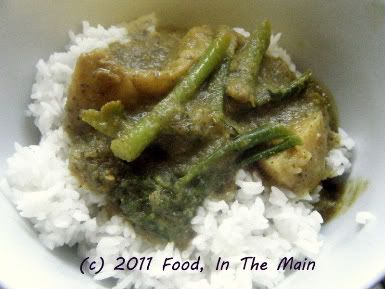 Ingredients:
1 medium onion
2 cloves garlic, sliced
Ingredients:
1 medium onion
2 cloves garlic, sliced
 1 tbsp coriander seeds
1/2 tsp fennel seeds
1/3 cup coriander leaves
2 green chillies
1" piece ginger, chopped
2 tsp oil
1/2 tsp turmeric powder
2 cups mixed vegetables (I used green beans, potatoes, courgettes), sliced into 1" pieces
1 cup light coconut milk
Salt to taste
1 cup water
Method:
1. Toast the coriander seeds in a dry skillet till they turn aromatic and dark. Let cool.
1 tbsp coriander seeds
1/2 tsp fennel seeds
1/3 cup coriander leaves
2 green chillies
1" piece ginger, chopped
2 tsp oil
1/2 tsp turmeric powder
2 cups mixed vegetables (I used green beans, potatoes, courgettes), sliced into 1" pieces
1 cup light coconut milk
Salt to taste
1 cup water
Method:
1. Toast the coriander seeds in a dry skillet till they turn aromatic and dark. Let cool.
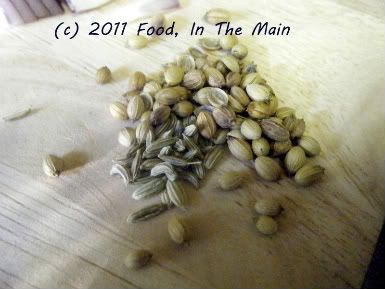 2. First grind together the green chillies, ginger, garlic, coriander seeds and fennel seeds;
2. First grind together the green chillies, ginger, garlic, coriander seeds and fennel seeds;
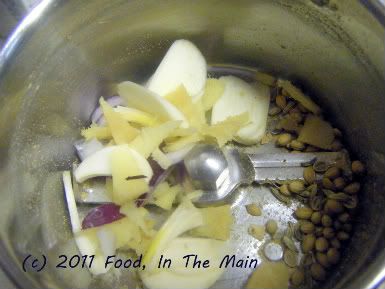 then add the coriander leaves
then add the coriander leaves
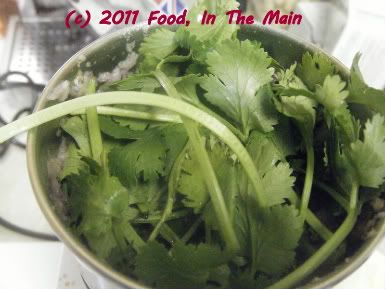 and grind to a smooth paste.
and grind to a smooth paste.
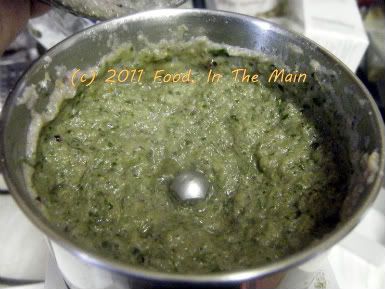 3. Heat the oil in a pan and add the ground paste and turmeric powder.
3. Heat the oil in a pan and add the ground paste and turmeric powder.
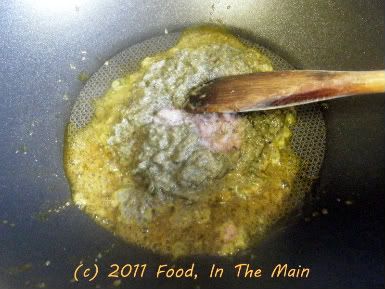 Fry the paste for a minute or so, stirring continuously. Then add the onions and let them cook for 5 minutes or so, till they start to turn soft.
4. Add the vegetables and stir-fry for 3-4 minutes, then add 1 cup water and bring the water to a gentle boil. Turn down the heat and simmer till the vegetables are nearly cooked.
5. Now pour in the coconut milk and stir, letting the curry simmer on medium-low till the vegetables are fully cooked.
Fry the paste for a minute or so, stirring continuously. Then add the onions and let them cook for 5 minutes or so, till they start to turn soft.
4. Add the vegetables and stir-fry for 3-4 minutes, then add 1 cup water and bring the water to a gentle boil. Turn down the heat and simmer till the vegetables are nearly cooked.
5. Now pour in the coconut milk and stir, letting the curry simmer on medium-low till the vegetables are fully cooked.
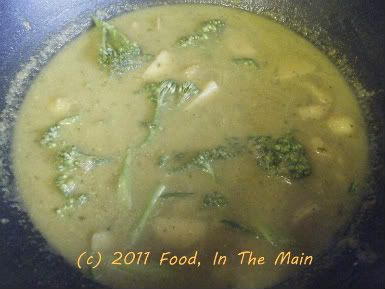 Add salt to taste and serve hot with plain white rice.
RECIPE: THAI-STYLE VEGETABLE CURRY
Ingredients:
1 medium onion
2 cloves garlic, sliced
1 tbsp coriander seeds
1/2 tsp fennel seeds
1/3 cup coriander leaves
2 green chillies
1" piece ginger, chopped
2 tsp oil
1/2 tsp turmeric powder
2 cups mixed vegetables (I used green beans, potatoes, courgettes), sliced into 1" pieces
1 cup light coconut milk
Salt to taste
1 cup water
Method:
1. Toast the coriander seeds in a dry skillet till they turn aromatic and dark. Let cool.
2. First grind together the green chillies, ginger, garlic, coriander seeds and fennel seeds, then add the coriander leaves.
3. Heat the oil in a pan and add the ground paste and turmeric powder. Fry the paste for a minute or so, stirring continuously. Then add the onions and let them cook for 5 minutes or so, till they start to turn soft.
4. Add the vegetables and stir-fry for 3-4 minutes, then add 1 cup water and bring the water to a gentle boil. Turn down the heat and simmer till the vegetables are nearly cooked.
5. Now pour in the coconut milk and stir, letting the curry simmer on medium-low till the vegetables are fully cooked. Add salt to taste and serve hot with plain white rice.
Add salt to taste and serve hot with plain white rice.
RECIPE: THAI-STYLE VEGETABLE CURRY
Ingredients:
1 medium onion
2 cloves garlic, sliced
1 tbsp coriander seeds
1/2 tsp fennel seeds
1/3 cup coriander leaves
2 green chillies
1" piece ginger, chopped
2 tsp oil
1/2 tsp turmeric powder
2 cups mixed vegetables (I used green beans, potatoes, courgettes), sliced into 1" pieces
1 cup light coconut milk
Salt to taste
1 cup water
Method:
1. Toast the coriander seeds in a dry skillet till they turn aromatic and dark. Let cool.
2. First grind together the green chillies, ginger, garlic, coriander seeds and fennel seeds, then add the coriander leaves.
3. Heat the oil in a pan and add the ground paste and turmeric powder. Fry the paste for a minute or so, stirring continuously. Then add the onions and let them cook for 5 minutes or so, till they start to turn soft.
4. Add the vegetables and stir-fry for 3-4 minutes, then add 1 cup water and bring the water to a gentle boil. Turn down the heat and simmer till the vegetables are nearly cooked.
5. Now pour in the coconut milk and stir, letting the curry simmer on medium-low till the vegetables are fully cooked. Add salt to taste and serve hot with plain white rice.
Serendipity isn't something that manifests itself often in my life, so the rare occasions that it does, it's very exciting. On the day after I made the baked cabbage-onion masala vadas, I saw a recipe for vada-kari (literal meaning "curry made from vadas") on Srivalli's blog. There I was, with day-old vadas to hand, and there it was, a recipe to use them - like I said, exciting!
I think this particular curry must originaly have come about as a way of using up stale, hard vadas that would not otherwise be edible to most people - the fact that I like to nibble on them is by the way. I'm not most people. Nor are, I suspect, most people me. (It works both ways, as you can see. Hehe.)
Anyway, I changed very little from the original recipe, except perhaps the quantities. Oh, and I omitted the fried gram because I didn't have any, and reduced the quantity of coconut. It was one heck of a tasty curry, and the plump vadas, juicy from soaking up the liquid from the gravy, were delicious. I had them over rice with a simple cabbage-peas dry curry. Yum-my. Thank you, Srivalli's mother, for providing the recipe for vada-kari.
Man, do I love ever my fellow-food bloggers and their wide variety of homespun recipes! Long live the Internet, I say.
Recipe for: Vada-kari (lentil fritters in tomato-coconut gravy)
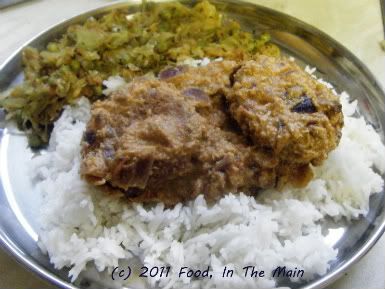 Ingredients:
About 8 day-old paruppu vadas (baked or fried)
1 medium tomato, chopped
1 medium onion, chopped fine
1 tsp ginger-garlic, grated
Ingredients:
About 8 day-old paruppu vadas (baked or fried)
1 medium tomato, chopped
1 medium onion, chopped fine
1 tsp ginger-garlic, grated
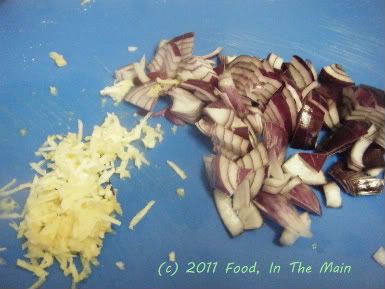 3 tsp oil
Salt to taste
Coriander leaves for garnish
For the ground masala:
3 tsp oil
Salt to taste
Coriander leaves for garnish
For the ground masala:
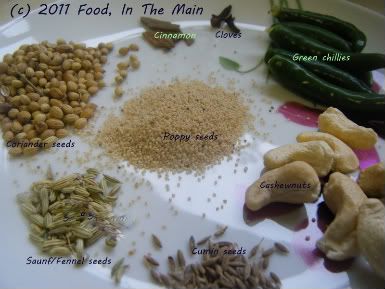 1/2 tsp fennel/saunf
1 tsp coriander seeds
1 tsp poppy seeds
1/4 tsp cumin seeds
1/2" piece cinnamon stick
2 cloves
3-5 fresh green chillies
5 cashewnuts
5-6 coconut pieces, each about 2cm long (or 2 tbsp grated coconut)
Method:
1. Heat one tsp of oil and fry all the ingredients for the ground masala till aromatic.
1/2 tsp fennel/saunf
1 tsp coriander seeds
1 tsp poppy seeds
1/4 tsp cumin seeds
1/2" piece cinnamon stick
2 cloves
3-5 fresh green chillies
5 cashewnuts
5-6 coconut pieces, each about 2cm long (or 2 tbsp grated coconut)
Method:
1. Heat one tsp of oil and fry all the ingredients for the ground masala till aromatic.
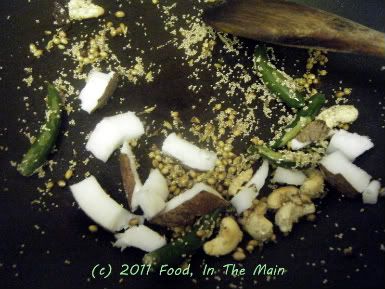 Add the coconut pieces/grated coconut and stir-fry for another two minutes, then remove to a plate and set aside to cool.
2. Heat the other tsp of oil and fry the tomatoes till they are mushy. Set aside to cool.
Add the coconut pieces/grated coconut and stir-fry for another two minutes, then remove to a plate and set aside to cool.
2. Heat the other tsp of oil and fry the tomatoes till they are mushy. Set aside to cool.
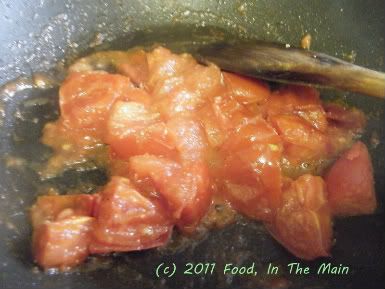 3. Once they are all cool, grind the fried ingredients and the tomatoes to a smooth paste using a little warm water if necessary. Reserve.
3. Once they are all cool, grind the fried ingredients and the tomatoes to a smooth paste using a little warm water if necessary. Reserve.
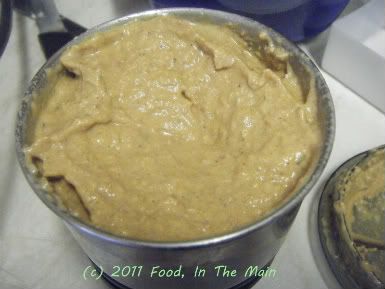 4. Now heat the remaining oil and add the ginger-garlic paste, stirring for 30 seconds or so.
5. Then add the onions and fry till they become soft and turn pale brown.
4. Now heat the remaining oil and add the ginger-garlic paste, stirring for 30 seconds or so.
5. Then add the onions and fry till they become soft and turn pale brown.
 6. Next, add the ground masala paste and stir it in,
6. Next, add the ground masala paste and stir it in,
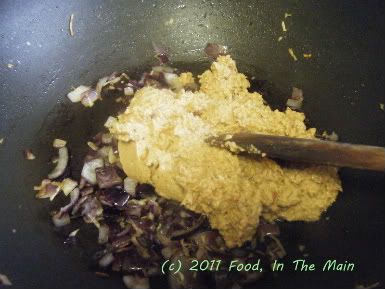 adding a cupful of water.
adding a cupful of water.
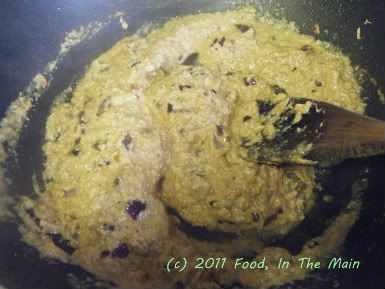 You can add a little more water at this stage, depending on how many vadas you have.
You can add a little more water at this stage, depending on how many vadas you have.
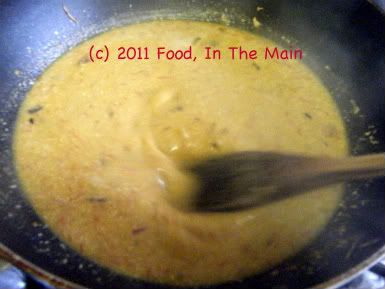 5. Bring to a gentle boil over medium heat and simmer the gravy for 5 minutes or so, till it comes together and starts to thicken.
6. Drop the vadas into the gravy now and simmer the curry for 2-3 minutes, spooning the gravy over the vadas occasionally, if necessary.
5. Bring to a gentle boil over medium heat and simmer the gravy for 5 minutes or so, till it comes together and starts to thicken.
6. Drop the vadas into the gravy now and simmer the curry for 2-3 minutes, spooning the gravy over the vadas occasionally, if necessary.
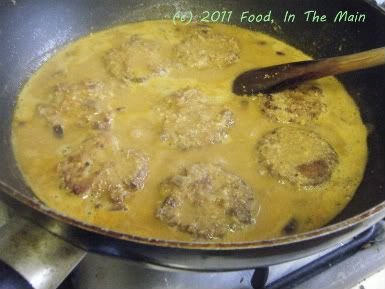 Garnish with coriander leaves and serve hot with idlis or dosas, or over rice if you like. Add a dry vegetable curry for a complete meal.
Note: If the curry sits for a while, the vadas will absorb the moisture and make the curry very thick.
RECIPE: VADA-KARI (LENTIL FRITTERS IN TOMATO-COCONUT GRAVY)
Ingredients:
About 8 day-old paruppu vadas (baked or fried)
1 medium tomato, chopped
1 medium onion, chopped fine
1 tsp ginger-garlic paste
3 tsp oil
Salt to taste
Coriander leaves for garnish
For the ground masala:
1/2 tsp fennel/saunf
1 tsp coriander seeds
1 tsp poppy seeds
1/4 tsp cumin seeds
1/2" piece cinnamon stick
2 cloves
3-5 fresh green chillies
5 cashewnuts
5-6 coconut pieces, each about 2cm long (or 2 tbsp grated coconut)
Method:
1. Heat one tsp of oil and fry all the ingredients for the ground masala till aromatic. Add the coconut pieces/grated coconut and stir-fry for another two minutes, then remove to a plate and set aside to cool.
2. Heat the other tsp of oil and fry the tomatoes till they are mushy. Set aside to cool.
3. Once they are all cool, grind the fried ingredients and the tomatoes to a smooth paste using a little warm water if necessary. Reserve.
4. Now heat the remaining oil and add the ginger-garlic paste, stirring for 30 seconds or so.
5. Then add the onions and fry till they become soft and turn pale brown.
6. Next, add the ground masala paste and stir it in, adding a cupful of water. You can add a little more water at this stage, depending on how many vadas you have.
5. Bring to a gentle boil over medium heat and simmer the gravy for 5 minutes or so, till it comes together and starts to thicken.
6. Drop the vadas into the gravy now and simmer the curry for 2-3 minutes, spooning the gravy over the vadas occasionally, if necessary.
Garnish with coriander leaves and serve hot with idlis or dosas, or over rice if you like. Add a dry vegetable curry for a complete meal.
Note: If the curry sits for a while, the vadas will absorb the moisture and make the curry very thick.
Garnish with coriander leaves and serve hot with idlis or dosas, or over rice if you like. Add a dry vegetable curry for a complete meal.
Note: If the curry sits for a while, the vadas will absorb the moisture and make the curry very thick.
RECIPE: VADA-KARI (LENTIL FRITTERS IN TOMATO-COCONUT GRAVY)
Ingredients:
About 8 day-old paruppu vadas (baked or fried)
1 medium tomato, chopped
1 medium onion, chopped fine
1 tsp ginger-garlic paste
3 tsp oil
Salt to taste
Coriander leaves for garnish
For the ground masala:
1/2 tsp fennel/saunf
1 tsp coriander seeds
1 tsp poppy seeds
1/4 tsp cumin seeds
1/2" piece cinnamon stick
2 cloves
3-5 fresh green chillies
5 cashewnuts
5-6 coconut pieces, each about 2cm long (or 2 tbsp grated coconut)
Method:
1. Heat one tsp of oil and fry all the ingredients for the ground masala till aromatic. Add the coconut pieces/grated coconut and stir-fry for another two minutes, then remove to a plate and set aside to cool.
2. Heat the other tsp of oil and fry the tomatoes till they are mushy. Set aside to cool.
3. Once they are all cool, grind the fried ingredients and the tomatoes to a smooth paste using a little warm water if necessary. Reserve.
4. Now heat the remaining oil and add the ginger-garlic paste, stirring for 30 seconds or so.
5. Then add the onions and fry till they become soft and turn pale brown.
6. Next, add the ground masala paste and stir it in, adding a cupful of water. You can add a little more water at this stage, depending on how many vadas you have.
5. Bring to a gentle boil over medium heat and simmer the gravy for 5 minutes or so, till it comes together and starts to thicken.
6. Drop the vadas into the gravy now and simmer the curry for 2-3 minutes, spooning the gravy over the vadas occasionally, if necessary.
Garnish with coriander leaves and serve hot with idlis or dosas, or over rice if you like. Add a dry vegetable curry for a complete meal.
Note: If the curry sits for a while, the vadas will absorb the moisture and make the curry very thick.
I was inspired to make these baked vadas – or rather, reminded that such a thing existed on my blog – by a new friend based in Australia when she wrote to me saying that she had made the vadas (adding flaxseed as per the original recipe on The Taste Tinkerer’s blog). That’s when I suddenly remembered how LOVELY the baked vadas had tasted and wondered why on earth (and how on earth too) I’d not made them in such a long time!
And naturally I wanted them immediately (or as close to immediately as I could get) – so I ended up soaking the dals at around 10.30 p.m, just as Pete was delicately putting forward a suggestion of retiring to bed. But I wasn’t sleepy – no, the Sandman had been pushed into the background (and was probably sulking at being so rudely dismissed). I wanted to make those vadas there and then. Also, I was thrilled that I had flaxseeds at hand… and when you’re in the grip of a sudden obsession backed by having all the requisite ingredients – well, ya gotta do what ya gotta do, as they say.
By the way, I soaked the dals in very hot water for quick results because of the lateness of the hour, but the preferable method is to soak the dals in water for a few hours so that they rehydrate naturally.
So by 11 p.m, I was doing what I hadda do with the soaked dals, adding finely shredded cabbage as well as onions to make the batter... and 15 minutes later, the Sandman had officially given up on Pete as well, as he (Pete) had been awakened well and truly by the AMAZING aroma of the baking vadas that was wafting around the house.
By 11.40 p.m or so, I was taste-testing very hot baked masala vadas fresh from the oven, while Pete watched me somewhat grumpily – he was left out of the whole vada love-fest because they contained (to him) insane amounts of fresh chillies. Well, how was I to know he’d want some too?
But don’t worry, gentle reader… I satisfied his suddenly-awakened vada craving the next evening by baking some more vadas just for him at a reasonable hour of the evening, to the general satisfaction and happiness of all concerned (the Sandman included).
Recipe for: Baked cabbage-onion masala vada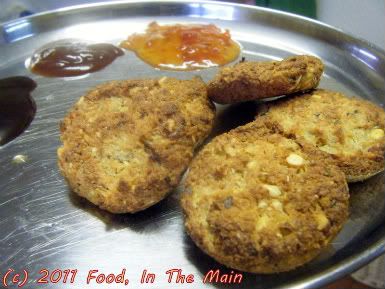
Ingredients:
1/2 cup chana dal
1/2 cup toor dal
1/3 cup flax seeds
1/3 cup red onion, chopped
1/3 cup green cabbage, shredded
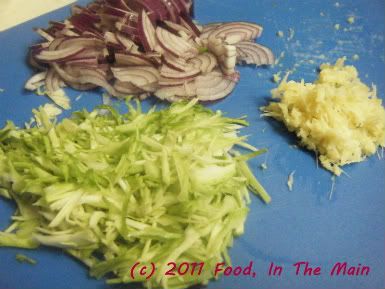
3-5 fresh green/red chillies
3-4 tbsp roasted peanuts, coarsely crushed
1" piece ginger
a few curry leaves, torn up (optional)
1 tsp baking powder
1 tbsp oil
Salt to taste
Oil-spray/Pam
1. Soak the chana dal and toor dal for 3-4 hours.
2. Grind a handful of the dals along with the flax seeds, red chillies and ginger to a smooth paste, adding a little water.
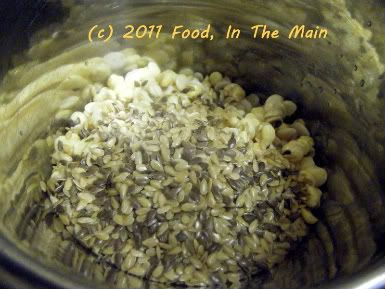
3. Next, add the remaining dal, the red onion and cabbage and grind to a coarse consistency using as little water as possible. The batter must be thick enough to hold its shape when made into patties.
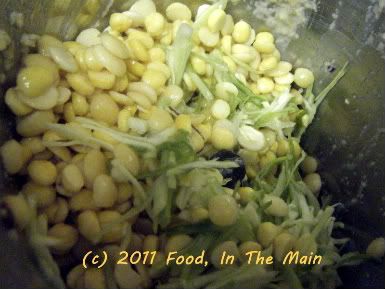
4. Turn the batter out into a bowl and add the 1 tbsp oil, salt to taste, peanuts and 1 tsp baking powder. Stir thoroughly to ensure the ingredients are mixed in evenly.
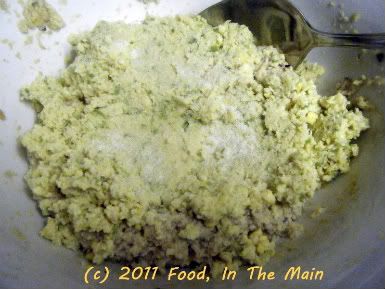
4. Grease a small cupcake or mini-muffin tray, then place lime-sized pieces of the batter in the depressions, patting them level with the top of the tray.
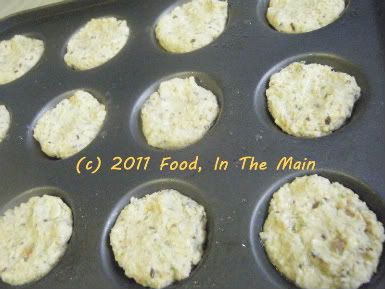
5. Heat the oven to 180C/350F. Spray the tops of the batter with Pam or brush lightly with oil, and bake for 15-20 minutes in the middle of the oven, turning the tray around mid-way. When the vadas are golden brown on top, turn off the heat.
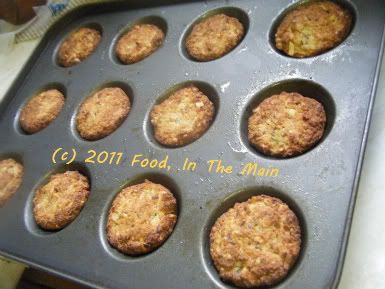
Let the vadas remain in the tray for 5 minutes, then turn them out. Serve hot as a snack with dips or chutney. These are best eaten hot and fresh, as they tend to become somewhat dry the next day and aren't as much fun to eat as a snack.
RECIPE: BAKED CABBAGE-ONION MASALA VADA
Ingredients:
1/2 cup chana dal
1/2 cup toor dal
1/3 cup flax seeds
1/3 cup red onion, chopped
1/3 cup green cabbage, shredded
3-5 fresh green/red chillies
3-4 tbsp roasted peanuts, coarsely crushed
1" piece ginger
a few curry leaves, torn up (optional)
1 tsp baking powder
1 tbsp oil
Salt to taste
Oil-spray/Pam
Method:
1. Soak the chana dal and toor dal for 3-4 hours.
2. Grind a handful of the dals along with the flax seeds, red chillies and ginger to a smooth paste, adding a little water.
3. Next, add the remaining dal, the red onion and cabbage and grind to a coarse consistency using as little water as possible. The batter must be thick enough to hold its shape when made into patties.
4. Turn the batter out into a bowl and add the 1 tbsp oil, salt to taste, peanuts and 1 tsp baking powder. Stir thoroughly to ensure the ingredients are mixed in evenly.
5. Grease a small cupcake or mini-muffin tray, then place lime-sized pieces of the batter in the depressions, patting them level with the top of the tray.
6. Heat the oven to 180C/350F. Spray the tops of the batter with Pam or brush lightly with oil, and bake for 15-20 minutes in the middle of the oven, turning the tray around mid-way. When the vadas are golden brown on top, turn off the heat.
7. Let the vadas remain in the tray for 5 minutes, then turn them out. Serve hot as a snack with dips or chutney. These are best eaten hot and fresh, as they tend to become somewhat dry the next day and aren't as much fun to eat as a snack.
Yep, I've jumped onto the "rice salad" bandwagon, despite my doubts about what a salad actually is. :) Or perhaps I should call this a no-cook "raw" pulao. A salad by any other name - probably tastes exactly the same... right? I actually wasn't entirely certain if this would be to my taste, but as it turned out, it's delicious - IF you like raw onions. I do, and I think the salad tasted even better for sitting overnight in the fridge, when I had it the next day for lunch. At room temperature, I should add. I don't like to eat anything that's refrigerator-cold... not even sandwiches. It has to be room temperature, at the very least.
PS. I saw this recipe on someone's blog, but for the life of me I can't remember whose it was. If you recognise this recipe, dear blogger, please give me a heads-up and I will add a link to your original recipe together with an acknowledgement.
Recipe for: Curried brown rice salad
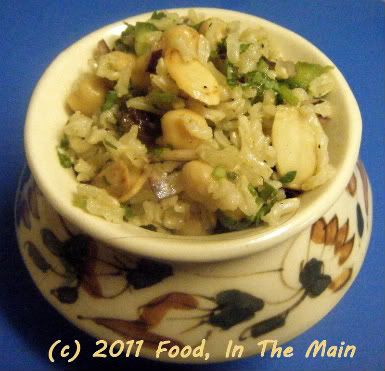 Ingredients:
Ingredients:
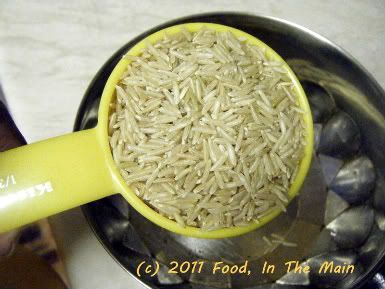 1/3 cup brown basmati rice
1/3 cup brown basmati rice
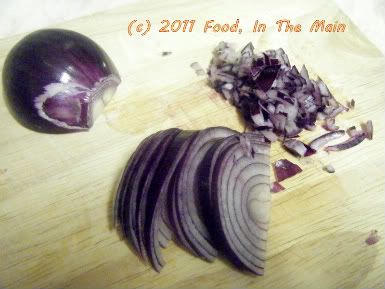 2 tbsp red onion, minced
2 tbsp green bell pepper, minced
1/3 cup chickpeas, cooked (fresh or canned)
3 tbsp coriander, chopped fine
1 tsp sultanas/raisins
2 tbsp red onion, minced
2 tbsp green bell pepper, minced
1/3 cup chickpeas, cooked (fresh or canned)
3 tbsp coriander, chopped fine
1 tsp sultanas/raisins
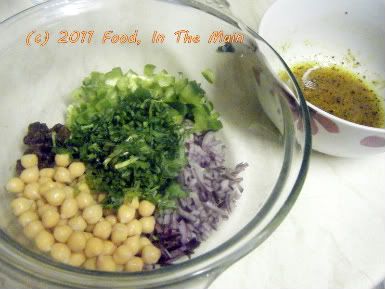 1 tsp sliced almonds, toasted, for garnish
For the dressing:
1 tbsp lime juice
1 tsp orange blossom honey
2 tsp extra virgin olive oil
1 tsp commercial curry powder (I used Schwartz medium-hot)
Salt and pepper to taste
Method:
1. Soak the brown rice for a few hours if possible; put the soaked rice in a pan with a well fitting lid and add 2/3 cup water. Bring to a boil, then turn the heat down to a gentle simmer, cover the pan and let the rice cook till all the water has been absorbed (about 15 minutes). Let the cooked rice sit undisturbed for 15 minutes.
1 tsp sliced almonds, toasted, for garnish
For the dressing:
1 tbsp lime juice
1 tsp orange blossom honey
2 tsp extra virgin olive oil
1 tsp commercial curry powder (I used Schwartz medium-hot)
Salt and pepper to taste
Method:
1. Soak the brown rice for a few hours if possible; put the soaked rice in a pan with a well fitting lid and add 2/3 cup water. Bring to a boil, then turn the heat down to a gentle simmer, cover the pan and let the rice cook till all the water has been absorbed (about 15 minutes). Let the cooked rice sit undisturbed for 15 minutes.
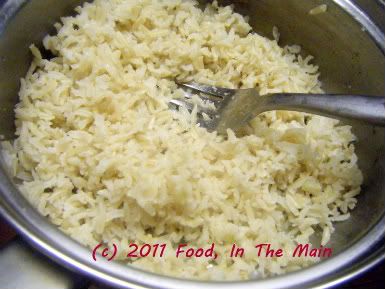 Once it has cooled, fluff gently with a fork. Reserve.
2. In a medium bowl, mix the salad ingredients bar the toasted almonds.
Once it has cooled, fluff gently with a fork. Reserve.
2. In a medium bowl, mix the salad ingredients bar the toasted almonds.
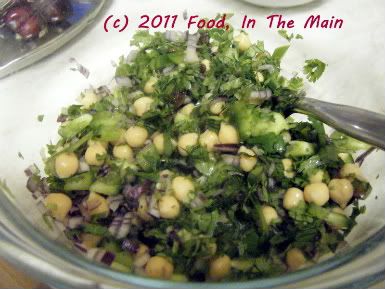 Then add the rice and mix gently to combine.
3. In a small bowl, whisk the ingredients for the dressing.
Then add the rice and mix gently to combine.
3. In a small bowl, whisk the ingredients for the dressing.
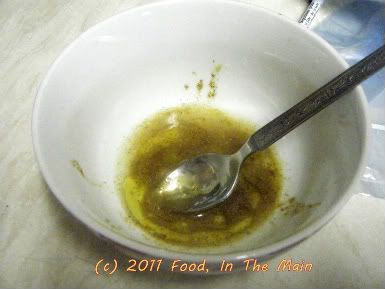 Pour the dressing over the salad and mix again, adding salt and pepper. Taste and adjust the dressing ingredients.
Pour the dressing over the salad and mix again, adding salt and pepper. Taste and adjust the dressing ingredients.
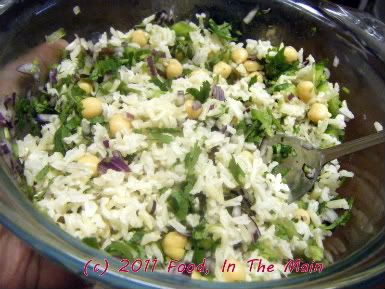 Fluff with a fork so as not to make the rice mushy.
Fluff with a fork so as not to make the rice mushy.
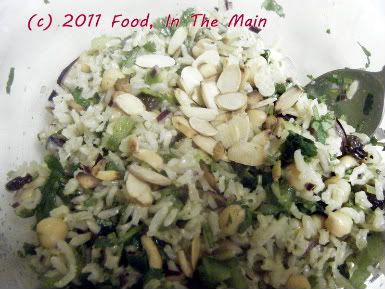 Sprinkle the toasted almonds over. Serve at room temperature, or chilled.
RECIPE: CURRIED BROWN RICE SALAD
Ingredients:
1/3 cup brown rice
2 tbsp red onion, minced
2 tbsp green bell pepper, minced
1/3 cup chickpeas
3 tbsp coriander, chopped fine
1 tsp sultana/raisins
1 tsp sliced almonds, toasted
For the dressing:
1 tbsp lime juice
1 tsp orange blossom honey
1 tsp extra virgin olive oil
1 tsp commercial curry powder (I used Schwartz medium-hot)
Salt and pepper to taste
Method:
1. Soak the brown rice for a few hours if possible; put the soaked rice in a pan with a well fitting lid and add 2/3 cup water. Bring to a boil, then turn the heat down to a gentle simmer, cover the pan and let the rice cook till all the water has been absorbed (about 15 minutes). Let the cooked rice sit undisturbed for 15 minutes. Once it has cooled, fluff gently with a fork. Reserve.
2. In a medium bowl, mix the salad ingredients bar the toasted almonds. Then add the rice and mix gently to combine.
3. In a small bowl, whisk the ingredients for the dressing. Pour the dressing over the salad and mix again, adding salt and pepper. Taste and adjust the dressing ingredients. Fluff with a fork so as not to make the rice mushy. Serve at room temperature.
Sprinkle the toasted almonds over. Serve at room temperature, or chilled.
RECIPE: CURRIED BROWN RICE SALAD
Ingredients:
1/3 cup brown rice
2 tbsp red onion, minced
2 tbsp green bell pepper, minced
1/3 cup chickpeas
3 tbsp coriander, chopped fine
1 tsp sultana/raisins
1 tsp sliced almonds, toasted
For the dressing:
1 tbsp lime juice
1 tsp orange blossom honey
1 tsp extra virgin olive oil
1 tsp commercial curry powder (I used Schwartz medium-hot)
Salt and pepper to taste
Method:
1. Soak the brown rice for a few hours if possible; put the soaked rice in a pan with a well fitting lid and add 2/3 cup water. Bring to a boil, then turn the heat down to a gentle simmer, cover the pan and let the rice cook till all the water has been absorbed (about 15 minutes). Let the cooked rice sit undisturbed for 15 minutes. Once it has cooled, fluff gently with a fork. Reserve.
2. In a medium bowl, mix the salad ingredients bar the toasted almonds. Then add the rice and mix gently to combine.
3. In a small bowl, whisk the ingredients for the dressing. Pour the dressing over the salad and mix again, adding salt and pepper. Taste and adjust the dressing ingredients. Fluff with a fork so as not to make the rice mushy. Serve at room temperature.







































